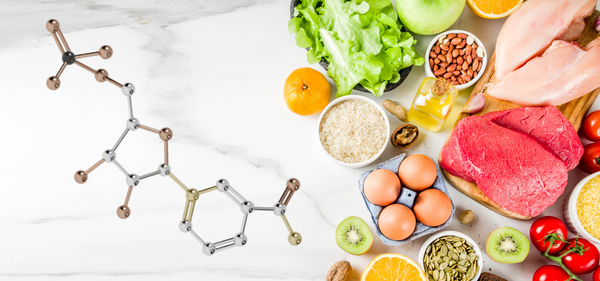HIGH GI OR LOW GI – WHAT REALLY WORKS FOR ATHLETES OVER 35?

High GI and Low GI – we often hear these terms thrown around in the context of athlete nutrition, but what does GI really mean for an athlete and how does it affect performance and health, especially for the over-35s?
Where do our muscles get their energy?
Our muscles’ primary source of energy for endurance sports is glucose. This is sourced from a number of places, including from carbohydrates which are digested and absorbed into the blood stream, from our existing but limited stores of glycogen in our muscles, and also from our abundant fat stores.
What does GI even mean?
Any type of carbohydrate, whether it is of the fruit and vegetable variety or of the more ‘traditionally’ deemed carbohydrates such as bread and pasta, is essentially made up of sugars. The relative composition of these sugars determines where the food type sits on the Glycaemic Index (GI), which ranks foods from 1-100 according to their effect on blood glucose levels, and is a measure of the relative impact of post-digestion blood glucose and insulin response of different foods.
Food sources which are made up of simple sugars, such as fizzy drinks or energy gels, are high GI (>70) and digested and absorbed rapidly, whereas more complex sugar sources such as whole wheat pasta or rice, have a low GI (<55) and are digested and absorbed more slowly.
How do these types of food affect our energy levels?
When high GI food items are broken down in the digestive system, they are absorbed quickly as simple sugars, which causes a significant spike in blood glucose. Many popular energy drinks and gels are high in glucose, sucrose or a combination of these types of sugars.

In response to a surge in blood glucose, the body produces a rush of the hormone insulin to try and restore the blood glucose to normal levels. Insulin does so by delivering the glucose to the working muscles for immediate use. However, the body typically over-compensates in dealing with the abnormal blood glucose levels, and as a result, the blood glucose levels fall below normal levels resulting in hypoglycaemia – or what we know as a ‘sugar crash,’ causing a significant dip in energy levels.
Consuming low GI carbohydrates avoids the peaks and crashes associated with high GI carbohydrates. The total energy delivered per gram is equivalent; however it is released into the blood stream over a sustained period which means that our blood glucose levels don’t go through the extreme reactions – both peaks and crashes – that are experienced with high GI foods.
Where does the excess energy go?
Where the body has an excess of glucose over its immediate requirements it will try to store it for later as glycogen. There is a however a limit to how much glycogen that we can store so once that limit is reached the body converts the rest to fat. There doesn’t seem to be the same limited storage capacity when it comes to fat unfortunately!
So where does age come into it?
While from an overall health perspective – regardless of age – we should limit our intake of high GI foods in our diet, there are added incentives to do so as we age. Consuming excessive amounts of high GI foods can cause insulin resistance, and there have been a number of studies which link insulin resistance to age related disease including heart disease, hypertension and Type 2 diabetes*.
There are other disadvantages too. By consuming high GI carbohydrates with the resulting elevation in blood glucose levels, we reduce the body’s need to burn fat during endurance exercise. Typically the body will try to spare its glycogen levels by using the slower to convert but energy rich fat stores. However, if blood glucose levels are elevated the body will not seek out fat as an energy source when glucose is so readily available.
Again, as we age, our metabolism slows, so we want to try and encourage our bodies to continue burning fat as fuel not just to stay healthy but also to help assist us with participation in endurance sports.
So what makes Elivar different?

Elivar is very different to other sports products as it uses a low GI carbohydrate called isomaltulose as its main energy source. Isomaltulose occurs naturally in honey and is easily digestible, derived exclusively from pure beet sugar. Elivar’s products deliver a sustained release energy source which is more beneficial for older athletes as it avoids the peaks and crashes associated with high GI products, while also allowing the body utilise its abundant fat stores rather than increase them!
As a general rule of thumb, it is best to stick to lower GI foods to maintain health over the long term, prevent weight gain, maintain a healthy metabolism and sustain controlled and regulated energy levels, whether training or not.
About Elivar
Elivar – Sports Nutrition optimised for athletes over 35 year old. Our bodies change as we age, so should our sports nutrition.
Elivar products provide a Low GI alternative to the sugary world of traditional sports nutrition. Try our ENDURE or HYDRATE PLUS during training products and feel the benefits of a Low GI energy source.
Try our Weekend Endurance Pack – fuel a weekend’s training with a selection of our Endure, Recover and Hydrate products for only £12.99
References
* Insulin Resistance as a Predictor of Age-Related Diseases, Facchini et al., 2000
Also in News

Elivar's Sustain Go! Energy Gels Fuelling BigFeat Events' Success
BigFeat Events, recognized for orchestrating captivating endurance events, stands out for its dynamic blend of cycling and running sportives. The recent "Beast to the East" cycling sportive, held on May 21st, is a sterling example of their commitment to crafting exhilarating experiences. A cornerstone of the success and popularity of these events has been the provision of Sustain Go! energy gels, generously sponsored by Elivar.
Previous running and events such as the "Bigwayround Trail Run" and "BigSea Trail Run" also benefited from the free distribution of Sustain Go! energy gels, much to the participants' delight. The energy boost and quicker recovery offered by these gels have consistently been instrumental in empowering athletes to perform their best.

NMN: Boosting Your Health from the Kitchen to the Medicine Cabinet
Did you know that Nicotinamide Mononucleotide (NMN), the star ingredient in numerous anti-aging supplements, also moonlights in several foods you might already enjoy? It's true! NMN is a vital precursor to NAD+, a molecule crucial to many biological processes, like cell growth, DNA repair, and metabolism. But as we age, NAD+ levels take a hit, and bolstering them through NMN intake can be beneficial. Now the question arises, can we simply count on our daily meals for our NMN fix?

